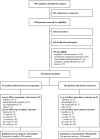Effectiveness of an internet-based perioperative care programme to enhance postoperative recovery in gynaecological patients: cluster controlled trial with randomised stepped-wedge implementation
- PMID: 29382673
- PMCID: PMC5829654
- DOI: 10.1136/bmjopen-2017-017781
Effectiveness of an internet-based perioperative care programme to enhance postoperative recovery in gynaecological patients: cluster controlled trial with randomised stepped-wedge implementation
Abstract
Objective: To evaluate the implementation and effectiveness of an internet-based perioperative care programme for patients following gynaecological surgery for benign disease.
Design: Stepped-wedge cluster randomised controlled trial.
Setting: Secondary care, nine hospitals in the Netherlands, 2011-2014.
Participants: 433 employed women aged 18-65 years scheduled for hysterectomy and/or laparoscopic adnexal surgery.
Interventions: An internet-based care programme was sequentially rolled out using a multifaceted implementation strategy. Depending on the implementation phase of their hospital, patients were allocated to usual care (n=206) or the care programme (n=227). The care programme included an e-health intervention equipping patients with tailored personalised convalescence advice.
Main outcome measures: The primary outcome was duration until full sustainable return to work (RTW). The degree of implementation of the care programme was evaluated at the level of the patient, healthcare provider and organisation by indicators measuring internet-based actions by patients and providers.
Results: Median time until RTW was 49 days (IQR 27-76) in the intervention group and 62 days (42-85) in the control group. A piecewise Cox model was fitted to take into account non-proportionality of hazards. In the first 85 days after surgery, patients receiving the intervention returned to work faster than patients in the control group (HR 2.66, 95% CI 1.88 to 3.77), but this effect was reversed in the small group of patients that did not reach RTW within this period (0.28, 0.17 to 0.46). Indicators showed that the implementation of the care programme was most successful at the level of the patient (82.8%) and professional (81.7%).
Conclusions: Implementation of an internet-based care programme has a large potential to lead to accelerated recovery and improved RTW rates following different types of gynaecological surgeries.
Trial registration number: NTR2933; Results.
Keywords: minimally invasive surgery; organisation of health services; quality in healthcare; telemedicine.
© Article author(s) (or their employer(s) unless otherwise stated in the text of the article) 2018. All rights reserved. No commercial use is permitted unless otherwise expressly granted.
Conflict of interest statement
Competing interests: JRA reports a chair in insurance medicine paid by the Dutch Social Security Agency, and he is a stockholder of Evalua. JAFH reports grants from Samsung, Gideon Richter and Celonova, outside the submitted work. HAMB reports grants from Olympus and personal fees from Nordic Farma, during the conduct of the study. JRA and JAFH intend to set up a spin-off company concerning the implementation of a mobile application concerning the ikherstel intervention in the Netherlands. The remaining authors have nothing to disclose.
Figures



Similar articles
-
Cost-effectiveness of an internet-based perioperative care programme to enhance postoperative recovery in gynaecological patients: economic evaluation alongside a stepped-wedge cluster-randomised trial.BMJ Open. 2018 Jan 21;8(1):e017782. doi: 10.1136/bmjopen-2017-017782. BMJ Open. 2018. PMID: 29358423 Free PMC article. Clinical Trial.
-
Personalised perioperative care by e-health after intermediate-grade abdominal surgery: a multicentre, single-blind, randomised, placebo-controlled trial.Lancet. 2018 Jul 7;392(10141):51-59. doi: 10.1016/S0140-6736(18)31113-9. Epub 2018 Jun 21. Lancet. 2018. PMID: 29937195 Clinical Trial.
-
The cost effectiveness of a tailored, web-based care program to enhance postoperative recovery in gynecologic patients in comparison with usual care: protocol of a stepped wedge cluster randomized controlled trial.JMIR Res Protoc. 2014 Jun 18;3(2):e30. doi: 10.2196/resprot.3236. JMIR Res Protoc. 2014. PMID: 24943277 Free PMC article.
-
A personalised eHealth programme reduces the duration until return to work after gynaecological surgery: results of a multicentre randomised trial.BJOG. 2014 Aug;121(9):1127-35; discussion 1136. doi: 10.1111/1471-0528.12661. Epub 2014 Feb 11. BJOG. 2014. PMID: 24511914 Clinical Trial.
-
Multidisciplinary convalescence recommendations after gynaecological surgery: a modified Delphi method among experts.BJOG. 2011 Dec;118(13):1557-67. doi: 10.1111/j.1471-0528.2011.03091.x. Epub 2011 Sep 7. BJOG. 2011. PMID: 21895950 Review.
Cited by
-
Cancer survivors and adverse work outcomes: associated factors and supportive interventions.Br Med Bull. 2023 Apr 5;145(1):60-71. doi: 10.1093/bmb/ldac028. Br Med Bull. 2023. PMID: 36372773 Free PMC article. Review.
-
Continued stepped care model improves early-stage self-report quality of life and knee function after total knee arthroplasty.Technol Health Care. 2024;32(6):4593-4601. doi: 10.3233/THC-240780. Technol Health Care. 2024. PMID: 39031415 Free PMC article. Clinical Trial.
-
Health Economic Evaluation Alongside Stepped Wedge Trials: A Methodological Systematic Review.Pharmacoeconomics. 2021 Jan;39(1):63-80. doi: 10.1007/s40273-020-00963-x. Epub 2020 Oct 5. Pharmacoeconomics. 2021. PMID: 33015754
-
Predictive factors of return to work after hysterectomy: a retrospective study.BMC Surg. 2022 Mar 4;22(1):84. doi: 10.1186/s12893-022-01533-y. BMC Surg. 2022. PMID: 35246078 Free PMC article.
-
Cost-effectiveness of an internet-based perioperative care programme to enhance postoperative recovery in gynaecological patients: economic evaluation alongside a stepped-wedge cluster-randomised trial.BMJ Open. 2018 Jan 21;8(1):e017782. doi: 10.1136/bmjopen-2017-017782. BMJ Open. 2018. PMID: 29358423 Free PMC article. Clinical Trial.
References
-
- Cox H. Recovery from gynaecological day surgery: are we underestimating the process. Ambul Surg 2003;10:114–21. 10.1016/S0966-6532(03)00007-6 - DOI
-
- Møller C, Ottesen M, Kehlet H, et al. . (Convalescence recommendations after hysterectomy. a study of opinions among Danish physicians). Ugeskr Laeger 2001;163:7043–7. - PubMed
-
- Ottesen M, Møller C, Kehlet H, et al. . Substantial variability in postoperative treatment, and convalescence recommendations following vaginal repair. a nationwide questionnaire study. Acta Obstet Gynecol Scand 2001;80:1062–8. - PubMed
Publication types
MeSH terms
Associated data
LinkOut - more resources
Full Text Sources
Medical
